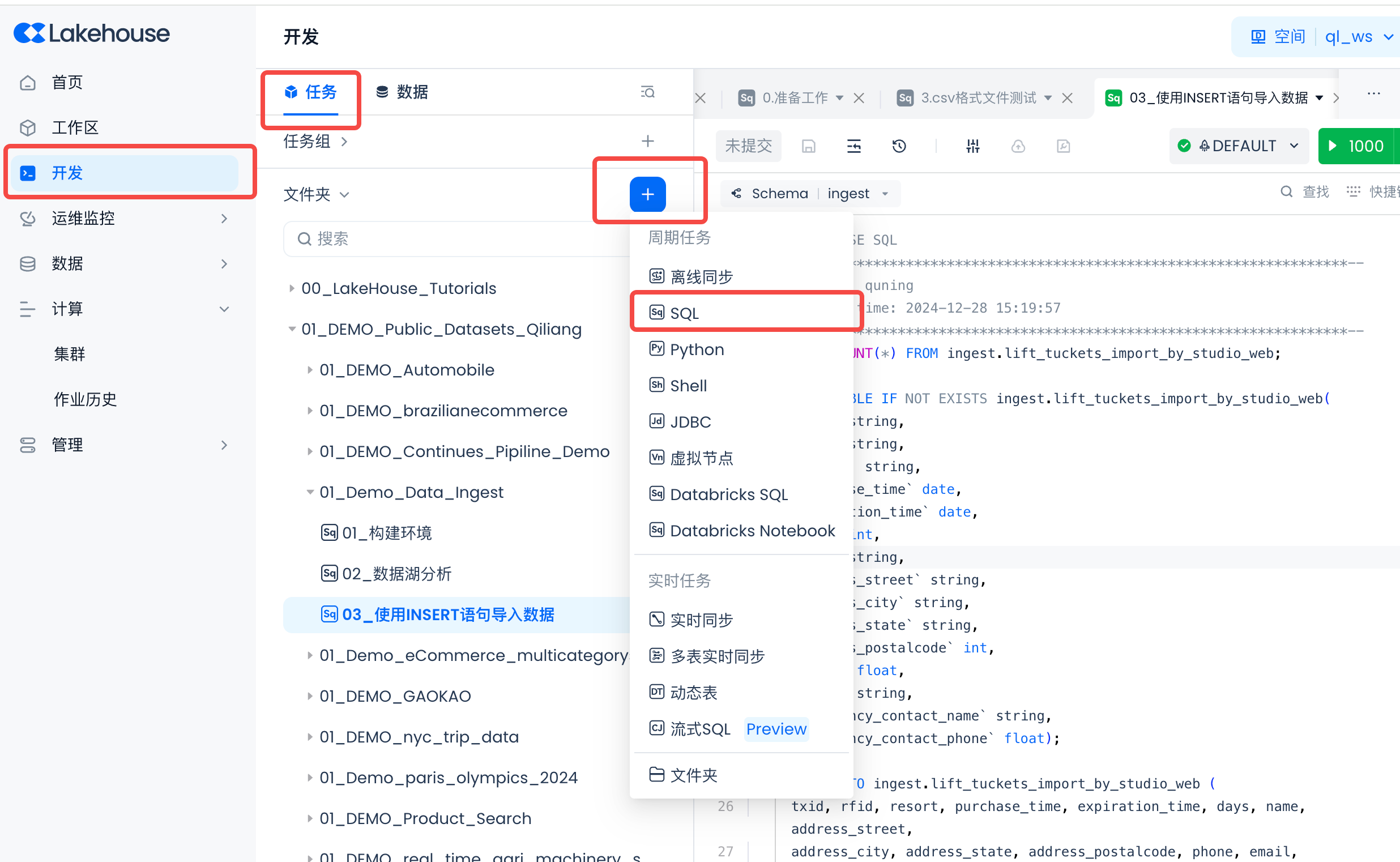Complete Guide to Importing Data into Singdata Lakehouse
Data Ingestion: Importing Data via SQL INSERT in Singdata Lakehouse Studio
Overview
In the Singdata Lakehouse platform, users can import data into the target table using the INSERT statement. INSERT supports various import methods, including direct value insertion, importing data from other tables, and importing data from external files. The following documentation will detail how to use the INSERT statement to import data, its use cases, operation examples, and precautions.
Method 1: Importing Data Using INSERT INTO VALUES Statement
Use Case
Suitable for manually importing small amounts of data, user debugging, and testing. For large-scale data processing, it is generally recommended to use batch insertion, streaming data import, and other more efficient methods to ensure the stability and efficiency of the data import process.
Implementation Steps
Navigate to Development -> Tasks, and click "+" to create a new SQL task (both methods below are implemented in the same task).

You can use the INSERT INTO VALUES statement to directly insert data. Multiple records are separated by commas.
--Method 1: Use the INSERT INTO SELECT FROM TABLE statement to insert
DROP TABLE IF EXISTS ingest.lift_tuckets_import_by_insert_into_values;
CREATE TABLE IF NOT EXISTS ingest.lift_tuckets_import_by_insert_into_values(
`txid` string,
`rfid` string,
`resort` string,
`purchase_time` timestamp_ltz,
`expiration_time` date,
`days` int,
`name` string,
`address_street` string,
`address_city` string,
`address_state` string,
`address_postalcode` string,
`phone` string,
`email` string,
`emergency_contact_name` string,
`emergency_contact_phone` string);
INSERT INTO ingest.lift_tuckets_import_by_insert_into_values (
txid, rfid, resort, purchase_time, expiration_time, days, name, address_street,
address_city, address_state, address_postalcode, phone, email, emergency_contact_name, emergency_contact_phone
) VALUES
('0056b1f3-79b0-455c-80e9-3b80c45ac61e', '0x39eb22cbb32e9e115917b6', 'Singdata One',
timestamp_ltz '2023-08-30 12:00:00', TO_DATE('2025-03-12', 'yyyy-MM-dd'), 2, 'She Xuemei', 'Guangzhou Road S Block',
'Yan City', 'Hebei Province', 853592, 13912709719, 'pchen@example.net', 'Lin Nan', 18041629236),
('52016065-1399-48cc-aed2-d4a525d90452', '0x121a00c15e41d8c3410c7490', 'Haidilao',
timestamp_ltz '2023-08-30 12:00:00', TO_DATE('2025-10-16', 'yyyy-MM-dd'), 3, 'Wei Chao', 'Shanghai Road R Block',
'Wei County', 'Hong Kong Special Administrative Region', 123342, 18259131600, 'panyan@example.net', 'Wei Yulan', 14795983190);
Method Two: Import Data Using INSERT INTO SELECT Statement
Usage Scenario
If you need to import data from another table, you can use the INSERT INTO SELECT statement. You can choose to import the entire table's data, or perform ETL operations such as selecting specific columns or performing data transformations.
Implementation Steps
Navigate to Development -> Tasks, and click "+" to create a new SQL task.
-- Method Two: Use the INSERT INTO SELECT FROM TABLE statement to insert
DROP TABLE IF EXISTS ingest.lift_tuckets_import_by_insert_into_select;
CREATE TABLE IF NOT EXISTS ingest.lift_tuckets_import_by_insert_into_select(
`txid` string,
`rfid` string,
`resort` string,
`purchase_time` timestamp_ltz,
`expiration_time` date,
`days` int,
`name` string,
`address_street` string,
`address_city` string,
`address_state` string,
`address_postalcode` string,
`phone` string,
`email` string,
`emergency_contact_name` string,
`emergency_contact_phone` string);
INSERT INTO ingest.lift_tuckets_import_by_insert_into_select
SELECT * FROM ingest.lift_tuckets_import_by_studio_web;
Method Three: Query Data from Volume Files and Import
Use Case
Singdata Lakehouse supports using INSERT INTO in combination with SELECT FROM VOLUME to directly import data from external files (such as CSV or Parquet files in cloud storage).
Note: In the case of uploading data files using ZettaPark, CSV and JSON format data files have already been uploaded to the Singdata Lakehouse data lake object ingest_demo.
Implementation Steps
Navigate to Development -> Tasks, and click "+" to create a new SQL task.
DROP TABLE IF EXISTS ingest.lift_tuckets_import_by_insert_into_select_from_volume;
CREATE TABLE IF NOT EXISTS ingest.lift_tuckets_import_by_insert_into_select_from_volume(
`txid` string,
`rfid` string,
`resort` string,
`purchase_time` timestamp_ltz,
`expiration_time` date,
`days` int,
`name` string,
`address_street` string,
`address_city` string,
`address_state` string,
`address_postalcode` string,
`phone` string,
`email` string,
`emergency_contact_name` string,
`emergency_contact_phone` string);
-- Import data using the results of the SELECT file
-- View the data files uploaded to Volume
SHOW VOLUME DIRECTORY ingest.ingest_demo;
-- Import using CSV format data files
INSERT INTO ingest.lift_tuckets_import_by_insert_into_select_from_volume
select * from volume ingest_demo(
`txid` string,
`rfid` string,
`resort` string,
`purchase_time` timestamp_ltz,
`expiration_time` date,
`days` int,
`name` string,
`address_street` string,
`address_city` string,
`address_state` string,
`address_postalcode` string,
`phone` string,
`email` string,
`emergency_contact_name` string,
`emergency_contact_phone` string
) using csv
options(
'header'='true',
'sep'=',',
'compression' = 'gzip'
) files('gz/lift_tickets_data.csv.gz');
-- Import using JSON format data files
INSERT INTO ingest.lift_tuckets_import_by_insert_into_select_from_volume
select * from volume ingest_demo(
`txid` string,
`rfid` string,
`resort` string,
`purchase_time` timestamp_ltz,
`expiration_time` date,
`days` int,
`name` string,
`address_street` string,
`address_city` string,
`address_state` string,
`address_postalcode` string,
`phone` string,
`email` string,
`emergency_contact_name` string,
`emergency_contact_phone` string
) using json
options(
'compression' = 'gzip'
) files('gz/lift_tickets_data.json.gz');
Besides CSV and JSON formats, Singdata Lakehouse also supports querying open format data such as Parquet, ORC, BSON, etc., through the SELECT FROM VOLUME method and importing it.
Documentation
SQL Insert Into
Create Table As

